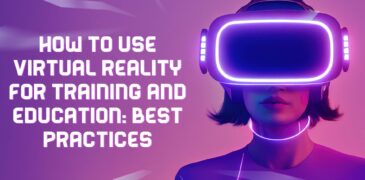Virtual Reality (VR) has revolutionized training and education by providing immersive, interactive experiences that simulate real-world scenarios. From medical simulations to vocational training and classroom learning, VR offers unparalleled opportunities for experiential learning. In this guide, we’ll explore best practices for leveraging VR in training and education. We’ll delve into effective instructional design principles, VR hardware and software considerations, content development strategies, and case studies highlighting successful implementations. Whether you’re an educator, trainer, or organization seeking to enhance learning outcomes, this guide will provide valuable insights and practical tips for harnessing the power of VR to engage learners and facilitate skill development.
Introduction to Virtual Reality in Training and Education
Virtual Reality (VR) has emerged as a transformative technology in the fields of training and education, offering immersive and interactive experiences that transcend traditional learning methods. By simulating real-world environments and scenarios, VR provides learners with hands-on experiences that enhance retention, engagement, and skill development.
In recent years, VR has gained traction across various industries, from healthcare and manufacturing to education and corporate training. This technology enables learners to explore virtual environments, practice tasks, and interact with objects and simulations in a safe and controlled setting. In this section, we’ll explore the potential of VR in training and education, examining its benefits, applications, and best practices for implementation. From instructional design principles to hardware and software considerations, we’ll delve into key aspects of utilizing VR to enhance learning outcomes and empower learners to acquire new knowledge and skills in innovative and immersive ways.
Understanding the Potential of Virtual Reality
Virtual Reality (VR) holds immense potential to revolutionize various aspects of training and education. By immersing users in simulated environments, VR offers unique opportunities for experiential learning, skill development, and knowledge retention.
One of the primary strengths of VR lies in its ability to create realistic and engaging scenarios that closely mimic real-world experiences. This enables learners to practice tasks, solve problems, and make decisions in a safe and controlled environment, without the risks associated with traditional training methods. In fields such as healthcare, aviation, and engineering, VR enables hands-on training in complex procedures and situations that would be impractical or costly to replicate in the physical world.
Best Practices in Instructional Design for VR
- Clear Learning Objectives: Define specific, measurable learning outcomes to guide VR content development and ensure alignment with training goals.
- Immersive Storytelling: Create compelling narratives and scenarios that immerse learners in realistic, relevant, and engaging experiences.
- Interactivity and Engagement: Design interactive elements, such as simulations, quizzes, and decision-making tasks, to encourage active participation and maintain learner engagement.
- User-Centered Design: Consider the needs, preferences, and abilities of the target audience when designing VR experiences to enhance usability and accessibility.
- Feedback and Assessment: Incorporate timely feedback mechanisms and performance assessments to provide learners with actionable insights and opportunities for improvement.
- Progressive Complexity: Scaffold learning experiences to gradually increase in complexity, allowing learners to build skills and confidence over time.
- Accessibility and Inclusivity: Ensure VR content is accessible to learners with diverse backgrounds, abilities, and learning styles through thoughtful design and inclusive features.
- Iterative Design Process: Continuously evaluate and iterate on VR content based on user feedback, performance data, and emerging best practices to enhance effectiveness and engagement.
Choosing the Right Virtual Reality Hardware and Software
- Hardware Considerations: Assess factors such as device compatibility, tracking capabilities, display quality, comfort, and affordability when selecting VR headsets and peripherals. Choose hardware that meets the specific requirements of your training or educational objectives.
- Software Compatibility: Ensure compatibility between VR hardware and software applications, including content creation tools, simulation platforms, and learning management systems. Consider the availability of software updates, technical support, and integration capabilities.
- Content Accessibility: Evaluate the availability and diversity of VR content libraries, applications, and experiences for your chosen hardware platform. Look for content that aligns with your training goals and educational needs, including interactive simulations, educational games, and immersive experiences.
- User Experience: Prioritize user experience and ease of use when selecting VR hardware and software. Consider factors such as setup complexity, user interface design, intuitive controls, and accessibility features to enhance usability and engagement for learners.
Developing Engaging and Effective VR Content
- Immersive Environments: Create visually stunning and interactive virtual environments that simulate real-world scenarios and captivate learners’ attention.
- Interactive Elements: Incorporate interactive elements such as simulations, gamified activities, and branching narratives to encourage active participation and engagement.
- Authenticity and Realism: Strive for authenticity and realism in VR content by accurately representing objects, environments, and interactions, enhancing immersion and learning outcomes.
- Multi-sensory Experiences: Leverage audio, haptic feedback, and spatial sound to create multi-sensory experiences that enhance immersion and reinforce learning.
- User-Centered Design: Design VR content with the end user in mind. Considering their needs, preferences, and learning objectives to ensure relevance and effectiveness.
Integrating Virtual Reality into Training and Education Programs
Integrating virtual reality (VR) into training and education programs offers a transformative approach to learning. It is providing immersive and interactive experiences that enhance engagement and retention. To effectively integrate VR into existing programs, educators and trainers must first identify learning objectives and assess. How VR can address specific training needs or educational goals. Next, they should select appropriate VR hardware and software. That align with the intended learning outcomes and audience preferences.
Developing customized VR content tailored to the curriculum ensures relevance and effectiveness. Additionally, incorporating VR experiences into blended learning approaches. Such as combining VR simulations with traditional classroom instruction or online modules, maximizes flexibility and accessibility. Regular assessment and feedback allow for continuous improvement and refinement of VR integration strategies. Ensuring that virtual reality enhances learning experiences and contributes to the achievement of training and educational objectives effectively.
Evaluating the Effectiveness of Virtual Reality Training
Evaluating the effectiveness of virtual reality (VR) training is essential to assess. Its impact on learning outcomes and inform future instructional design decisions. Start by defining clear evaluation criteria and learning objectives aligned with the training goals. Use quantitative measures such as knowledge retention rates, skill proficiency improvements. And also performance metrics to assess the tangible outcomes of VR training.
Gather qualitative feedback from learners through surveys, interviews, and observations. To capture subjective experiences and perceptions of the training effectiveness. Compare the results of VR training evaluations with traditional training methods to identify the strengths and weaknesses of each approach. Continuously monitor and analyze data over time to track long-term retention and transfer of learning.
Case Studies: Successful Implementations of VR in Training and Education
- Medical Training: Hospitals and medical schools utilize VR simulations to train healthcare professionals in surgical procedures, patient diagnosis, and emergency scenarios. VR enables immersive hands-on practice in a safe and controlled environment, improving skill acquisition and patient outcomes.
- Manufacturing: Manufacturing companies implement VR training programs. To educate workers on equipment operation, assembly processes, and safety protocols. VR simulations allow employees to practice complex tasks and troubleshoot issues without disrupting production, leading to increased efficiency and reduced downtime.
- Military Training: Armed forces employ VR technology for combat training, tactical simulations, and vehicle operation. VR-based training enhances soldiers’ situational awareness. Decision-making skills, and teamwork abilities in realistic battlefield scenarios, improving readiness and mission success.
Overcoming Challenges and Considerations for VR Implementation
- Cost: VR hardware and software can be expensive. Requiring significant upfront investment for hardware, software development, and maintenance.
- Technical Complexity: Setting up and maintaining VR systems can be complex. Requiring technical expertise in hardware configuration, software integration, and troubleshooting.
- Content Development: Creating high-quality VR content requires specialized skills and resources. Including 3D modeling, programming, and multimedia production.
- User Comfort: Some users may experience discomfort or motion sickness when using VR. Necessitating careful design considerations to minimize discomfort and ensure a comfortable experience.
- Accessibility: Ensuring VR content is accessible to users with disabilities. Special needs requires additional considerations for inclusive design and compatibility with assistive technologies.
Conclusion
In conclusion, leveraging virtual reality (VR) for training and education presents unparalleled opportunities to enhance learning outcomes and engagement. By following best practices such as defining clear learning objectives, developing immersive content, integrating VR into existing programs, and evaluating effectiveness, organizations can maximize the benefits of VR technology. As VR hardware and software continue to evolve, and new advancements emerge, the future of VR in training and education looks promising, offering innovative, interactive, and personalized learning experiences that empower learners and drive success in diverse fields and industries.
Read more:







